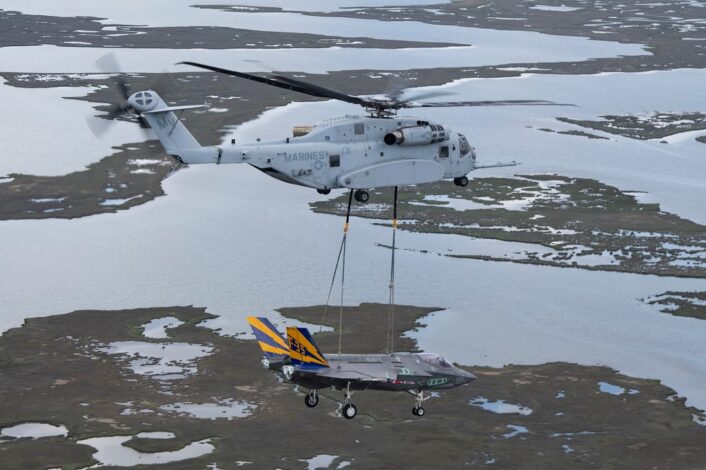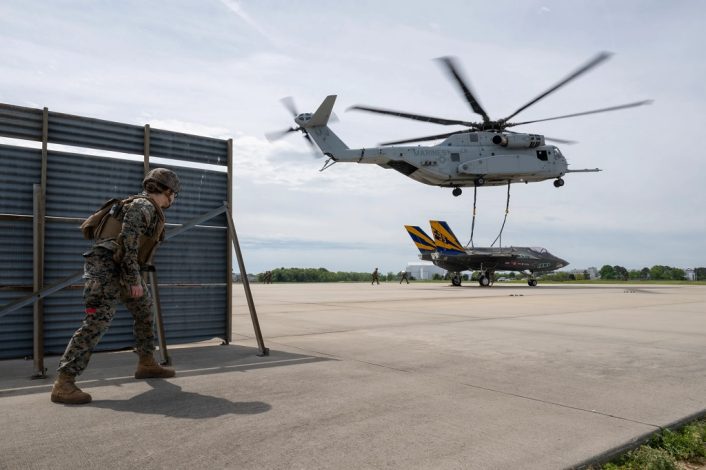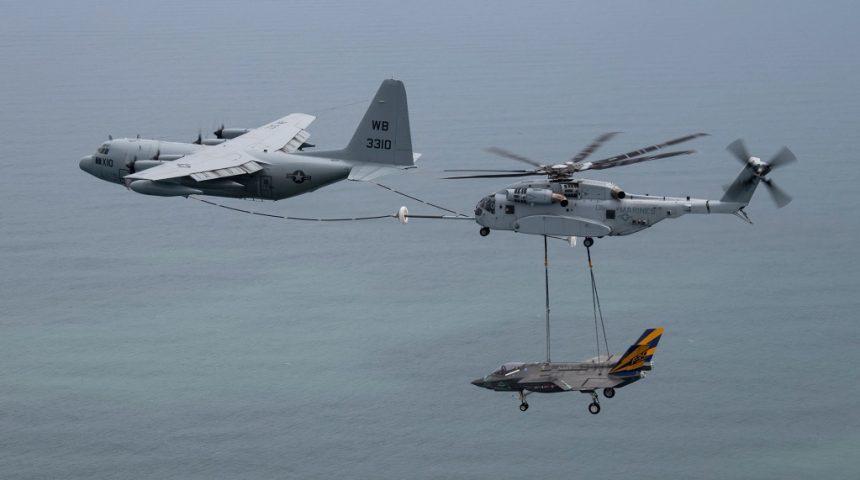CF-1 will be used in future emergency recovery systems testing by the Prototype, Manufacturing and Test Department of the Naval Air Warfare Center Aircraft Division.
A CH-53K King Stallion heavy lift helicopter from Marine Test and Evaluation Squadron 1 (VMX-1) was used to transport the first F-35C carrier variant aircraft, CF-1, from the F-35 Integrated Test Force at Patuxent River (Pax ITF) to a Navy unit located at Joint Base McGuire-Dix-Lakehurst, New Jersey, on April 24. The photos and video released show the helicopter also refueling from a KC-130T during the flight, which appears to have been performed over the coast to avoid overflying populated areas.
CF-1 was delivered to the Prototype, Manufacturing and Test (PMT) Department of the Naval Air Warfare Center Aircraft Division (NAWCAD) Lakehurst for use in future emergency recovery systems testing, according to the Pax ITF. The F-35C and rigging weighed about 22,000 pounds after removal of its mission and propulsion systems, outer wings, and additional equipment.
The CH-53K is currently cleared to conduct a 27,000-pound external lift and is projected to be cleared for a 36,000-pound external lift, nearly three-times more under high, hot conditions than its predecessor, the CH-53E. April 24, however, was not the first time the CH-53K sling loaded CF-1. In fact, in December 2023, the same aircraft was used to perform an external load certification lift to evaluate the load and inform future lift capabilities of the new helicopter.
The CH-53K King Stallion
The CH-53K, the most powerful helicopter ever developed by the United States government, is the United States Marine Corps’ heavy lift replacement for the CH-53E. This new-build helicopter will continue to fill the CH-53E Super Stallion mission as a pillar of logistics and assault support for the U.S. Marine Corps efforts, but with significant improvements such as state-of-the-art, fly-by-wire technology reducing pilot workload, contributing to aircraft stability, and improving overall safety.

The CH-53K is designed to carry 27,000 lbs (12,247 kg) at a mission radius of 110 nautical miles (203 km), in Navy high/hot environments, which is almost triple the baseline of the CH-53E, while its maximum external lift capability is 36,000 lbs (16,329 kg). Some typical loads for which it was designed are two “up-armored” HMMWV or a Light Armored Vehicle variant.
The King Stallion is also designed to have a smaller shipboard footprint compared to the CH-53E, lower operating costs per aircraft, and fewer direct maintenance man hours per flight hour. The helicopter is also capable of landing and taking-off in a degraded visual environment such as the so-called “brown out”, one of the most dangerous phenomena when operating in dusty environments like the desert. In fact, sand or dust particles become swept up in the rotor outwash and can obscure the pilot’s vision of the terrain, causing the loss of all external visual references.
The F-35C CF-1
CF-1 is the first developmental test carrier variant F-35C fighter jet that has been built. The F-35C is distinct from the F-35A and F-35B variants with its larger wing surfaces and reinforced landing gear for greater control in the demanding carrier take-off and landing environment. The test aircraft accumulated 750 flight hours during 450 test flights between 2010 and 2016.

CF-1 was used to performed performance, weapon and systems testing, including the type’s first air-to-air refueling and external weapons test flight. While it was also employed for preparatory testing before the employment on aircraft carriers, CF-1 has not been employed at sea, with the first F-35 operating on a carrier being CF-3 and CF-5.









